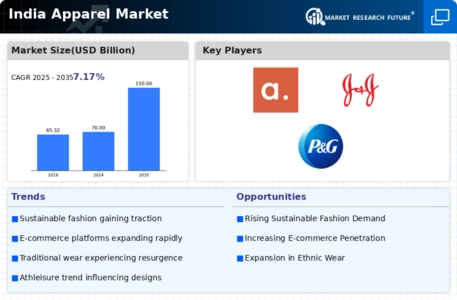Market Growth Chart
E-commerce Expansion
The rapid expansion of e-commerce platforms is a pivotal driver for the Global India Apparel Market Industry. With the proliferation of internet access and smartphone usage, online shopping has become increasingly popular among consumers. Major players in the apparel sector are investing heavily in digital platforms to reach a broader audience. This shift is expected to enhance market accessibility, allowing consumers to explore diverse brands and styles from the comfort of their homes. As a result, the e-commerce segment is anticipated to grow significantly, potentially contributing to the market's projected value of 150 USD Billion by 2035, indicating a robust shift in purchasing patterns.
Fashion Consciousness
A growing fashion consciousness among Indian consumers is significantly influencing the Global India Apparel Market Industry. As exposure to global fashion trends increases through social media and international media, consumers are becoming more discerning in their clothing choices. This trend is particularly pronounced among younger demographics, who prioritize style and brand over mere functionality. The demand for trendy and fashionable apparel is likely to drive innovation and creativity within the industry, prompting brands to adapt their offerings. This evolving consumer mindset could contribute to a compound annual growth rate of 7.17% from 2025 to 2035, reflecting a dynamic shift in market preferences.
Sustainability Trends
Sustainability has emerged as a critical driver within the Global India Apparel Market Industry, as consumers increasingly prioritize eco-friendly and ethically produced clothing. Brands are responding to this demand by adopting sustainable practices, such as using organic materials and implementing fair labor standards. This shift not only caters to environmentally conscious consumers but also aligns with global trends towards sustainability in fashion. As awareness of environmental issues grows, the market is likely to see a rise in demand for sustainable apparel, potentially influencing overall market growth. This trend may play a crucial role in shaping the future landscape of the apparel industry in India.
Government Initiatives
Government initiatives aimed at promoting the textile and apparel sector are playing a vital role in the Global India Apparel Market Industry. Policies such as the Production-Linked Incentive Scheme and various export promotion measures are designed to enhance the competitiveness of Indian apparel manufacturers. These initiatives are expected to stimulate domestic production, attract foreign investment, and boost exports. As a result, the market is likely to benefit from increased production capabilities and improved supply chain efficiencies. Such supportive measures may contribute to the anticipated growth trajectory of the market, aligning with the broader economic objectives of enhancing India's position in the global apparel landscape.
Rising Disposable Income
The Global India Apparel Market Industry is experiencing growth driven by increasing disposable incomes among the Indian population. As more individuals attain higher income levels, their purchasing power expands, leading to greater expenditure on apparel. In 2024, the market is projected to reach 70 USD Billion, reflecting a shift in consumer behavior towards branded and premium clothing. This trend is particularly evident in urban areas, where consumers are more inclined to invest in quality apparel. The rising middle class, estimated to grow significantly in the coming years, is likely to further bolster demand, contributing to the overall expansion of the market.




